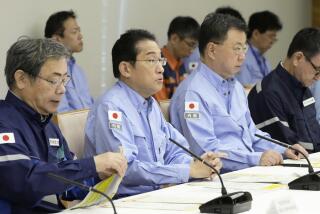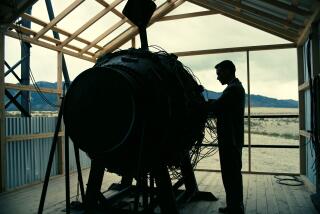Atomic bomb exhibit in Washington recalls days in Japan frozen in time
- Share via
Seven decades after the atomic bomb fell on the Japanese city of Hiroshima, a single pocket watch found amid the blast’s debris serves as a reminder. It’s stopped at 8:15, the time the bomb hit on the morning of Aug. 6, 1945.
Now a replica of the original watch and other artifacts found after the bombs hit Hiroshima and, three days later, Nagasaki, are on display until Aug. 16 at American University Museum in Washington.
A rosary, a sake container, a student’s cap, 20 items in all, provide a personal connection to the tens of thousands who were killed instantly after the United States bombed the Japanese cities to bring an end to World War II.
It’s estimated that at least 200,000 people were killed in the bombings.
But the book “The Bomb: A Life,” by Gerard DeGroot, also cites a 1946 report from analysts who worked on the Manhattan Project. “The atomic bomb did not win the war against Japan,” the book quotes the report as saying, “but it most certainly ended it, saving thousands of lives that would have been lost in any combat invasion.”
The discussion continues to this day.
The “Hiroshima-Nagasaki Atomic Bomb Exhibition” received accounts and photographs of the bomb blasts from Hiroshima Peace Memorial Museum and the Nagasaki Atomic Bomb Museum. The show also includes 15 screens created by the late Iri and Toshi Maruki that capture the horror of what happened.
The university museum says on its website the exhibition is meant to “deepen understanding of the damage wrought by nuclear weapons and inspire peace in the 21st century.”
To that end, both cities use their respective anniversary dates of the bombings to send letters of peace to leaders throughout the world.
In Hiroshima, temple bells sounded at 8:15 a.m. Thursday local time for a minute of reflection followed by events at the city’s memorial park. Afterward, people released paper lanterns on the city’s Motoyasu River to remember the victims.
Nagasaki will hold a vigil to remember the dead and other ceremonies in the Peace Park on Sunday.
The exhibition at American is free and open to the public; it is open 11 a.m. to 4 p.m. Tuesdays through Sundays.
Info: American University Museum; (202) 885-1300
READ MORE
What U.S. citizens weren’t told about the atomic bombing of Japan
Why humans can’t think straight about nuclear weapons
More to Read
Sign up for The Wild
We’ll help you find the best places to hike, bike and run, as well as the perfect silent spots for meditation and yoga.
You may occasionally receive promotional content from the Los Angeles Times.







